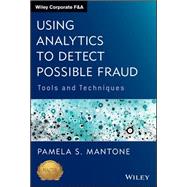Using Analytics to Detect Possible Fraud: Tools and Techniques is a practical overview of the first stage of forensic accounting, providing a common source of analytical techniques used for both efficiency and effectiveness in forensic accounting investigations. The book is written clearly so that those who do not have advanced mathematical skills will be able to understand the analytical tests and use the tests in a forensic accounting setting. It also includes case studies and visual techniques providing practical application of the analytical tests discussed.
- Shows how to develop both efficiency and effectiveness in forensic accounting
- Provides information in such a way that non-practitioners can easily understand
- Written in plain language: advanced mathematical skills are not required
- Features actual case studies using analytical tests
Essential reading for every investor who wants to prevent financial fraud, Using Analytics to Detect Possible Fraud allows practitioners to focus on areas that require further investigative techniques and to unearth deceptive financial reporting before it's too late.








